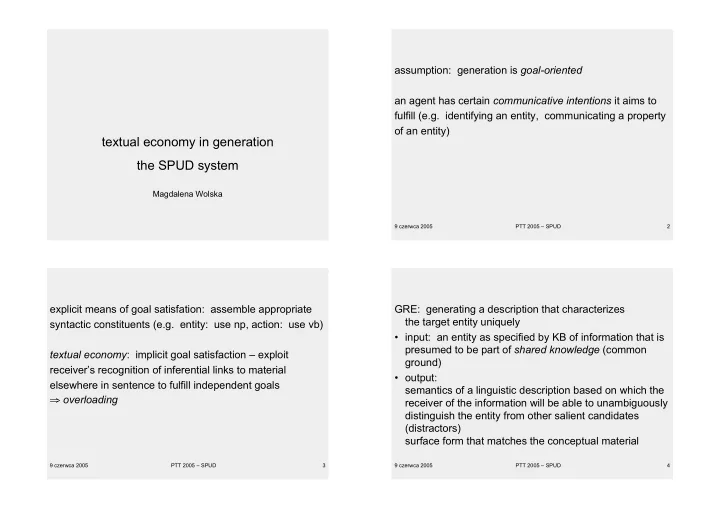

assumption: generation is goal-oriented an agent has certain communicative intentions it aims to fulfill (e.g. identifying an entity, communicating a property of an entity) textual economy in generation the SPUD system Magdalena Wolska 9 czerwca 2005 PTT 2005 – SPUD 2 explicit means of goal satisfation: assemble appropriate GRE: generating a description that characterizes the target entity uniquely syntactic constituents (e.g. entity: use np, action: use vb) • input: an entity as specified by KB of information that is presumed to be part of shared knowledge (common textual economy : implicit goal satisfaction – exploit ground) receiver’s recognition of inferential links to material • output: elsewhere in sentence to fulfill independent goals semantics of a linguistic description based on which the � overloading receiver of the information will be able to unambiguously distinguish the entity from other salient candidates (distractors) surface form that matches the conceptual material 9 czerwca 2005 PTT 2005 – SPUD 3 9 czerwca 2005 PTT 2005 – SPUD 4
„economy” in GRE : generate a description D to indentify r cf. full-brevity GRE: use as few properties as possible; in context set C just in case KB supports attribution of D when multiple descriptions apply, f-b: produce a more to r and motivates D in describing r in C complex description when shorter don’t refer uniquely support : there must exist information that r fits the description (else description may not be understood or r1 : the big black shaggy dog generated) r1 : the affable purebred racing dog the black racing dog motivation : there must be a reason to use each of the properties to describe r (else the generator may leave the desriptor out) 9 czerwca 2005 PTT 2005 – SPUD 5 9 czerwca 2005 PTT 2005 – SPUD 6 indredients of a GRE component: typical GRE scenario: • context set of entities that are explicit (or implicit) in • any fact to be communicated must fit into abstract discourse grammatical structure (including lexical items) • formalisation of properties of these entities • any reference to domain entity must be elaborated into a description that uniquely identifies (cf. incremental • specification of how to combine the properties into descrption) linguisitc description • surface form must be found • representation for processing � step-wise process • reasoning to online assess how receiver will interpret the (assuming e in common ground, 1/ identify set of concepts that together distinguish e given description from its distractors, 2/ derive syntactic structure that realises these concepts) � resource intensive 9 czerwca 2005 PTT 2005 – SPUD 7 9 czerwca 2005 PTT 2005 – SPUD 8
References Matthew Stone and Bonnie Webber. Textual Economy through Close Coupling of Syntax and SPUD: perform syntactic and semantic processes Semantics. Proceedings of INLG 1998, p. 178--187. simultaneously Martha E. Pollack. Overloading intentions for efficient practical reasoning. Nous 25(4):513--536. see also other references at: http://www.cs.rutgers.edu/~mdstone/nlg.html you can download SPUD at: http://www.cs.rutgers.edu/~mdstone/class/taglet/ (for instructions on running SPUD, you may contact Magdalena Wolska magda@coli.uni-sb.de) 9 czerwca 2005 PTT 2005 – SPUD 9 9 czerwca 2005 PTT 2005 – SPUD 10
Recommend
More recommend